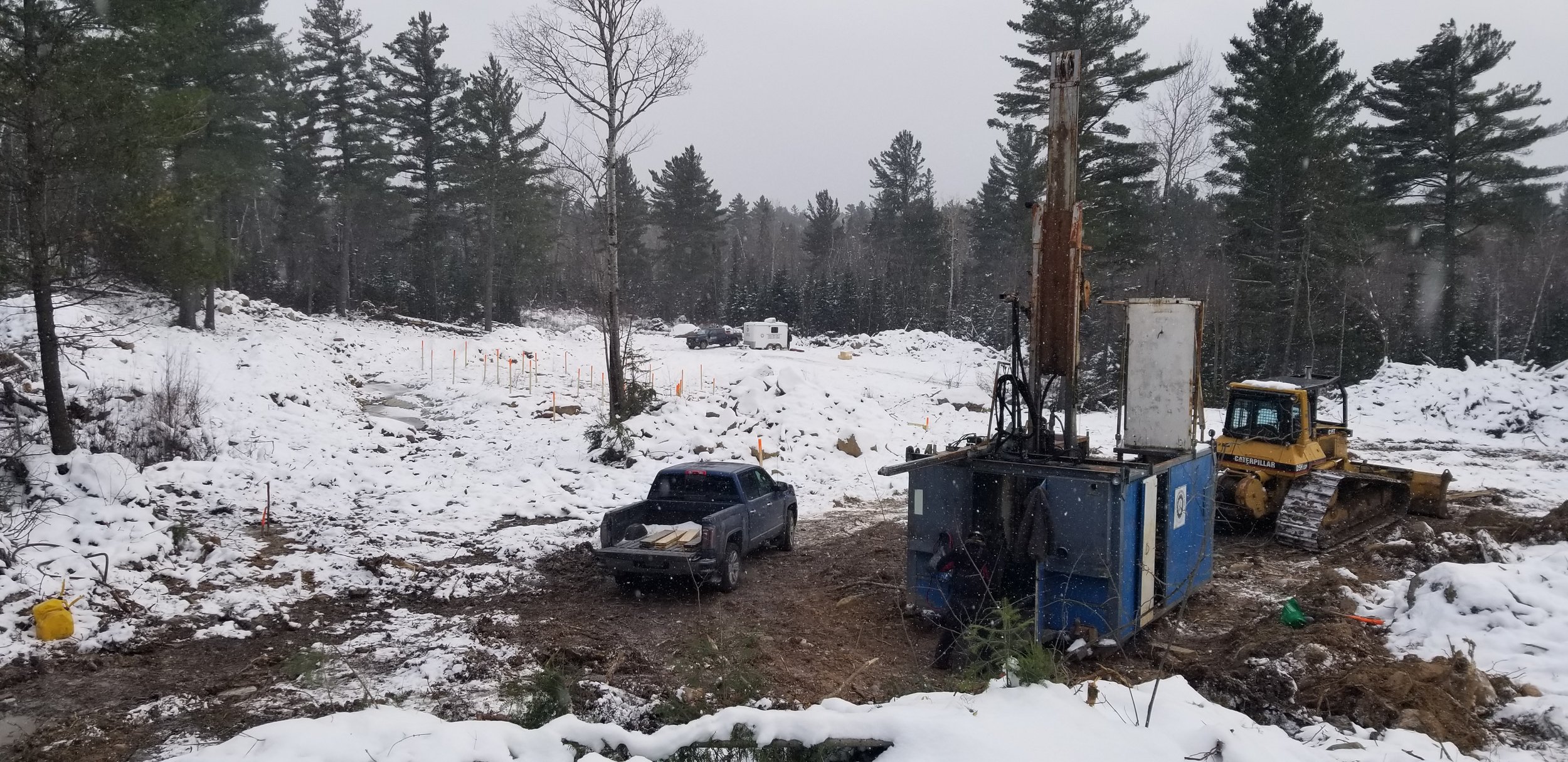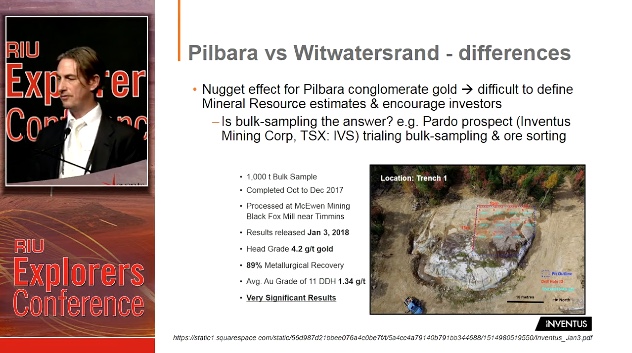Inventus intersects mineralization in its second hole at Cobalt Hill
The hole is currently at 209 metres depth. Mineralized breccia was intersected from 80 to 120 metres and again at 195 to 209 metres where the hole remains in mineralization.
Inventus drills mineralization in its first hole at Cobalt Hill
Surprisingly, Cobalt Hill mineralization has not been sampled for Cobalt or Nickel. Inventus surface samples have returned up to 16 g/t gold, 0.25% cobalt and 0.34% nickel. Samples from the first hole have been processed and are currently at the lab for assay.
Drilling Resumes in 2021
Our 2021 winter drill program has resumed and is currently approaching the target in our second hole.
Exploration Update
The induced polarization (IP) geophysical survey is complete and targets at the Laura Creek Offset Dyke are currently being drilled.
Answering some Sudbury 2.0 FAQs
We’ve received some questions about the exploration plans now that we have located a mineralized Sudbury Type Quartz Diorite Dyke at Laura Creek on our 100% property (see news release dated Sept 12, 2019). These days we can use geochemical fingerprinting to show that this dyke is a Sudbury Offset Dyke, which is an exciting development. We have decided to bring in an excavator to remove the soil and vegetation from the dyke so that we can sample the dyke in greater detail. Back in the early 1900’s someone went to a lot of trouble to excavate a shaft into the dyke, likely because it contains coarse gold.
Sample of a hydrothermal vein from within the quartz diorite dyke grading 2.68 g/t Au with one grain of coarse visible gold (red circle).
Historic shaft (likely early 1900’s) driven into the quartz diorite dyke. Slabs of inclusion bearing quartz diorite (IQD) in the foreground.
Here is a sample of the Sudbury Type quartz diorite from the Laura Creek Dyke for chemical analysis and age dating.
Oct 17, 2019 - Update:
Excavator making its way along an old logging road to access the Laura Creek Dyke.
Drilling almost complete
The final holes extending 007 to the North will be completed soon. Here are a couple of pictures from site. Assays are coming in from earlier drilling and we’re closing in on the first batch for release.
Quick Pardo Update
Last week we completed a 28 hole diamond drilling program at the 007 Zone. Assays should start to roll in from the lab later this week or early next. Additionally, we’ve gone back to do a few exploratory holes in the area while the weather is nice. The red line in the picture below indicates the location of a proposed channel sample.
Oct 2018 Drilling at 007 Zone
Diamond Drill On-site at 007
Similar to our 1,000 tonne bulk sample at Trench 1 in 2017 (results here http://www.inventusmining.com/s/Inventus_Jan3.pdf), the first step in the next phase of bulk sampling at 007 is to strip and diamond drill the area on a 5x5 m grid. The drill arrived today and should be operational tomorrow. This will enable us to define exactly where the eventual bulk sample will be taken, and give us an indication of the gold grade.
September 27, 2018 at 007 Zone
Summer Update
It has been a while since we provided an update here on the blog. We have been very busy working on Pardo and Sudbury 2.0, and we have a few near-term milestones:
1. New 43-101 Technical Report on Pardo is in the final stages of being competed. We look forward to getting this filed, potentially later this week.
2. The final closure plan for our 50kt bulk sample was officially submitted July 24th. There is approximately 45 day period for review.
3. Sudbury 2.0 prospecting, mapping, and sampling has been going well, and we have identified targets for geophysics to zero in on potential drill targets.
Progress Report Coming Monday, May 7
News release will update on Pardo bulk sample permitting, ore sorting, 43-101. Plus introduce an exciting new project we're kicking off. Here is a hint:
Very interesting presentation
Interesting talk about conglomerate hosted gold deposits by Mike Cunningham from the recent RIU explorers conference. He mentions our 1,000 t bulk sample at the 12:15 minute mark. https://www.na.srk.com/en/publication/ap-pilbaras-conglomerate-gold
Download the slides here: https://www.srk.com/sites/default/files/file/MCunningham_ConglomerateGoldExplorationAndSampling_2018.pdf
Ore Sorting at STEINERT
On February 15th the ore sorting was conducted at the STEINERT facility in Kentucky, USA.
This work was initiated as a follow up on previous test work that was very favourable. Initial test work indicated that 65% of the material could be removed as waste. The remaining 35% of the material contained 91% of the gold for an upgrade ratio of 160% (see press release April 5th 2017).
Theoretically, if we had sorted our 1,000-tonne bulk sample with a head grade of 4.2 gpt (see press release January 3rd, 2018) we would have only milled 345 tonnes (35% of 985 tonnes) with a total gold content of 121.7 Troy ounces (91% of 133.8 troy ounces) for a head grade of 10.8 gpt.
The potential to sort the mineralized conglomerate ore at Pardo is a game changer for the project. It would significantly reduce capital costs in a mining scenario and could potentially lower the cutoff grade of a future resource.
Extent of Gold Bearing Conglomerate
These are screen captures from the Pardo Leapfrog 3D model.
The interpreted extent of the mineralized conglomerate defined by drilling is displayed above in red. The mineralized conglomerate is open to the north west, east and south.
Plan view of the mineralized conglomerate with overlain aerial photo. Topography is rolling to flat with no major water bodies.
The extent and interpolated grade thickness of the mineralized conglomerate.
The Trench 1 bulk sample returned 4.2 gpt over 2.54 metres demonstrating a grade thickness (GT) of 10.66. The drilling conducted prior to the bulk sample ranged from 0.42 GT to 10.43 GT with an average of 3.37 GT.
Any one drill hole intersecting the mineralized conglomerate is not adequate to determine the grade. The highest grade thickness observed in drilling occurs where the highest density of drill holes are located.
Cross section of the grade thickness with aerial photo between 007 and Eastern Reef showing it is flat lying and near to surface.
Extent and grade thickness of the mineralized conglomerate with overlain aerial photo.
























